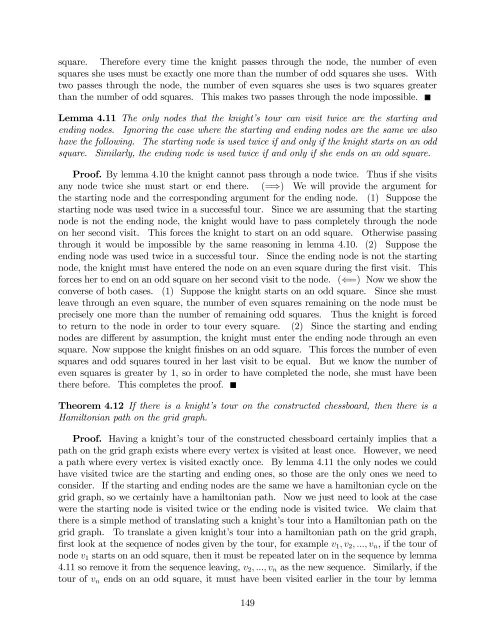Knight's Tour - Oregon State University
Knight's Tour - Oregon State University
Knight's Tour - Oregon State University
You also want an ePaper? Increase the reach of your titles
YUMPU automatically turns print PDFs into web optimized ePapers that Google loves.
square. Therefore every time the knight passes through the node, the number of evensquares she uses must be exactly one more than the number of odd squares she uses. Withtwo passes through the node, the number of even squares she uses is two squares greaterthan the number of odd squares. This makes two passes through the node impossible.Lemma 4.11 The only nodes that the knight’s tour can visit twice are the starting andending nodes. Ignoring the case where the starting and ending nodes are the same we alsohave the following. The starting node is used twice if and only if the knight starts on an oddsquare. Similarly, the ending node is used twice if and only if she ends on an odd square.Proof. By lemma 4.10 the knight cannot pass through a node twice. Thus if she visitsany node twice she must start or end there. (=⇒) We will provide the argument forthe starting node and the corresponding argument for the ending node. (1) Suppose thestarting node was used twice in a successful tour. Since we are assuming that the startingnode is not the ending node, the knight would have to pass completely through the nodeon her second visit. This forces the knight to start on an odd square. Otherwise passingthrough it would be impossible by the same reasoning in lemma 4.10. (2) Suppose theending node was used twice in a successful tour. Since the ending node is not the startingnode, the knight must have entered the node on an even square during the first visit. Thisforces her to end on an odd square on her second visit to the node. (⇐=) Now we show theconverse of both cases. (1) Suppose the knight starts on an odd square. Since she mustleave through an even square, the number of even squares remaining on the node must beprecisely one more than the number of remaining odd squares. Thus the knight is forcedto return to the node in order to tour every square. (2) Since the starting and endingnodes are different by assumption, the knight must enter the ending node through an evensquare. Now suppose the knight finishes on an odd square. This forces the number of evensquares and odd squares toured in her last visit to be equal. But we know the number ofeven squares is greater by 1, so in order to have completed the node, she must have beenthere before. This completes the proof.Theorem 4.12 If there is a knight’s tour on the constructed chessboard, then there is aHamiltonian path on the grid graph.Proof. Having a knight’s tour of the constructed chessboard certainly implies that apath on the grid graph exists where every vertex is visited at least once. However, we needa path where every vertex is visited exactly once. By lemma 4.11 the only nodes we couldhave visited twice are the starting and ending ones, so those are the only ones we need toconsider. If the starting and ending nodes are the same we have a hamiltonian cycle on thegrid graph, so we certainly have a hamiltonian path. Now we just need to look at the casewere the starting node is visited twice or the ending node is visited twice. We claim thatthere is a simple method of translating such a knight’s tour into a Hamiltonian path on thegrid graph. To translate a given knight’s tour into a hamiltonian path on the grid graph,first look at the sequence of nodes given by the tour, for example v 1 ,v 2 , ..., v n , if the tour ofnode v 1 starts on an odd square, then it must be repeated later on in the sequence by lemma4.11 so remove it from the sequence leaving, v 2 , ..., v n as the new sequence. Similarly, if thetour of v n ends on an odd square, it must have been visited earlier in the tour by lemma149
















